
Concept explainers
(a)
The real zeros of
(a)
Answer to Problem 11CR
Solution:
The real zeros of
Explanation of Solution
Given information:
The function,
Consider the function
By rational root theorem,
The divisors of the constant term are
The divisors of the leading coefficient are
Then, possible rational zeros of the polynomial are,
Now, test
Here, since the remainder is
After taking
Then, the depressed equation is
By quadratic formula, the zeros of the quadratic equation
The factors of
The factor form of
Hence, the real zeros of
is
(b)
The
(b)
Answer to Problem 11CR
Solution:
The
Explanation of Solution
Given information:
The function
To find
Thus the
Now to find
Hence the
(c)
The power function that the graph of
(c)
Answer to Problem 11CR
Solution:
Thegraph of the function
Explanation of Solution
Given information:
The function
The polynomial function is
Here the degree of the polynomial function
The graph of the function
(d)
To graph: The function
(d)
Explanation of Solution
Given information:
The function
Graph:
Use the steps below to graph the function using a graphing calculator.
Step I: Press the ON key.
Step II: Now, press [Y=]. Input the right hand side of the function
Step III: Press [WINDOW] key and set the viewing window as below,
Step IV: Then hit [Graph] key to view the graph.
The graph of the function is as follows:
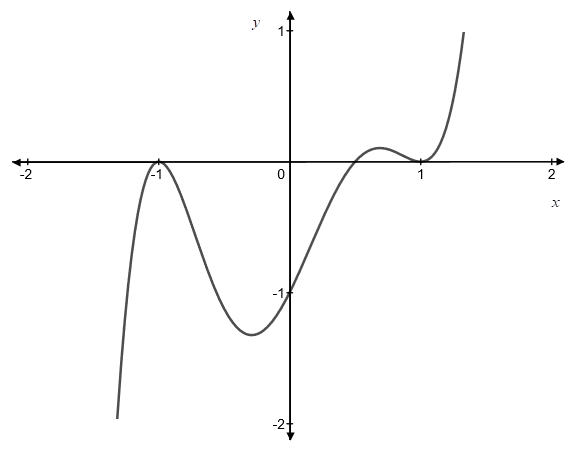
Interpretation:
The graph of the function
(e)
The approximation of the turning points, if exists, of the function
(e)
Answer to Problem 11CR
Solution:
The turning points of
Explanation of Solution
Given information:
The function
Let, the function
The maximum number of real zeros is the degree of the polynomial.
Here, the degree of
Since the polynomial function
For the approximation of the turning points find out the maxima and minima using a graphing calculator.
To graph the function
Step I: Press the ON key.
Step II: Now, press [Y=]. Input the right hand side of the function
Step III: Press [WINDOW] key and set the viewing window as below,
Step IV: Then hit [Graph] key to view the graph.
The graph of the function is as follows:
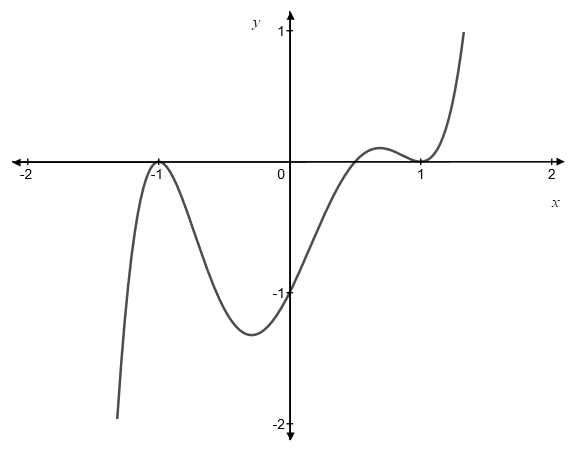
To find local maximum and local minimum on the graph using graphing utility use below steps,
Step IV: Press [2ND] [TRACE] to access the calculate menu
Step V: press [MAXIMUM] and press [ENTER].
Step VI: Set left bound by using the left and right arrow. Click [ENTER].
Step VII: Set right bound by using the left and right arrow. Click [ENTER].
Step VIII: Click [Enter] button twice.
It will give the maximum value
It will give the maximum value
Thus, the function have its local maximum value at
To find local minimum value use below steps.
Step IX: Press [2ND] [TRACE] to access the calculate menu
Step X: press [MINIMUM] and press [ENTER].
Step XI: Set left bound by using the left and right arrow. Click [ENTER].
Step XII: Set right bound by using the left and right arrow. Click [ENTER].
Step XIII: Click [Enter] button twice.
It will give the minimum value
It will give the minimum value
Thus, the function has its local minimum value at
Therefore, the turning points are
(f)
To graph: The function
(f)
Explanation of Solution
Given information:
The function
Graph:
The polynomial function is
From all the above parts, the analysis of the function
The graph of the function
Thezeros of the function are
The
The graph of the function
Here the degree of the polynomial function
Using all this information, the graph will look alike:
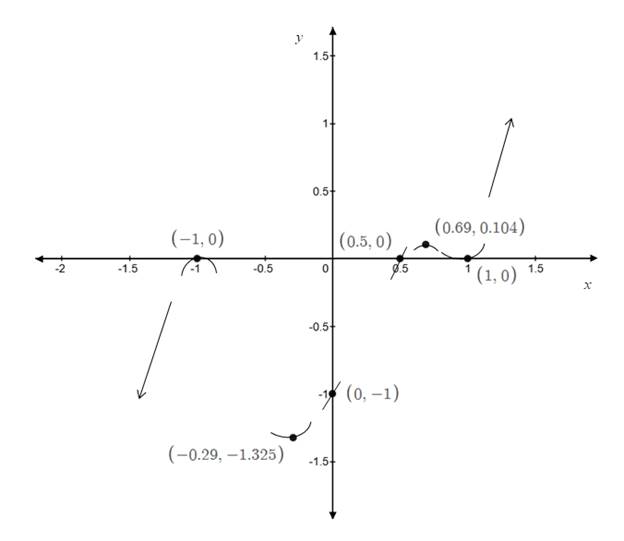
Now find additional points on the graph on each side of
For
For
For
For
For
For
For
Now plot all these coordinates
Therefore, the graph of the function is as follows:
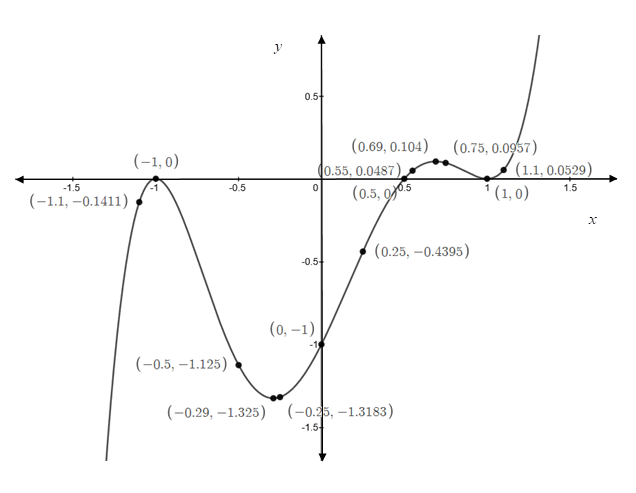
Interpretation:
The graph of the function
Thezeros of the function are
The
The graph of the function
Here the degree of the polynomial function
(g)
The intervals where the function
(g)
Answer to Problem 11CR
Solution:
The function
Explanation of Solution
Given information:
The function,
The polynomial function is
From parts (d),(e),(f) the graph of the function
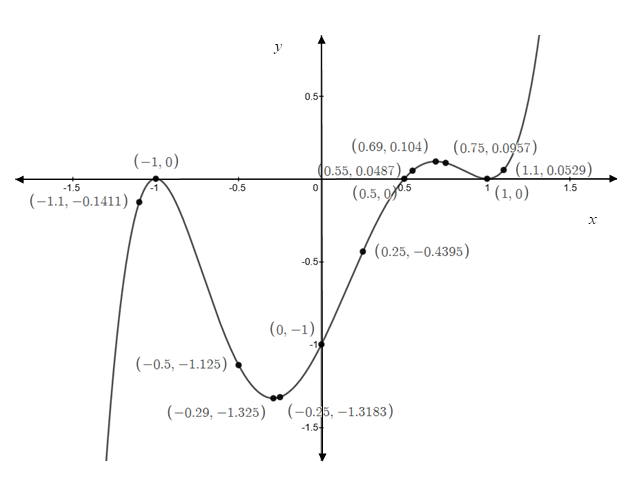
Here the degree of the polynomial function
From the graph, it is clearly evident the graph is increasing in the interval
Chapter 7 Solutions
Precalculus Enhanced with Graphing Utilities
Additional Math Textbook Solutions
University Calculus: Early Transcendentals (4th Edition)
Elementary Statistics: Picturing the World (7th Edition)
Elementary Statistics
Introductory Statistics
A Problem Solving Approach To Mathematics For Elementary School Teachers (13th Edition)
Pre-Algebra Student Edition
- 2. A tank with a capacity of 650 gal. originally contains 200 gal of water with 100 lb. of salt in solution. Water containing 1 lb. of salt per gallon is entering at a rate of 4 gal/min, and the mixture is allowed to flow out of the tank at a rate of 3 gal/min. a. Find the amount of salt in the tank at any time prior to the instant when the tank begins to overflow (650 gallons). b. Find the concentration (in pounds per gallon) of salt in the tank when the tank hits 400 gallons. D.E. for mixture problems: dv dt=11-12 dA A(t) dtarrow_forward- Suppose that you have the differential equation: dy = (y - 2) (y+3) dx a. What are the equilibrium solutions for the differential equation? b. Where is the differential equation increasing or decreasing? Show how you know. Showing them on the drawing is not enough. c. Where are the changes in concavity for the differential equation? Show how you know. Showing them on the drawing is not enough. d. Consider the slope field for the differential equation. Draw solution curves given the following initial conditions: i. y(0) = -5 ii. y(0) = -1 iii. y(0) = 2arrow_forward5. Suppose that a mass of 5 stretches a spring 10. The mass is acted on by an external force of F(t)=10 sin () and moves in a medium that gives a damping coefficient of ½. If the mass is set in motion with an initial velocity of 3 and is stretched initially to a length of 5. (I purposefully removed the units- don't worry about them. Assume no conversions are needed.) a) Find the equation for the displacement of the spring mass at time t. b) Write the equation for the displacement of the spring mass in phase-mode form. c) Characterize the damping of the spring mass system as overdamped, underdamped or critically damped. Explain how you know. D.E. for Spring Mass Systems k m* g = kLo y" +—y' + — —±y = —±F(t), y(0) = yo, y'(0) = vo m 2 A₁ = √c₁² + C₂² Q = tan-1arrow_forward
- 4. Given the following information determine the appropriate trial solution to find yp. Do not solve the differential equation. Do not find the constants. a) (D-4)2(D+ 2)y = 4e-2x b) (D+ 1)(D² + 10D +34)y = 2e-5x cos 3xarrow_forward3. Determine the appropriate annihilator for the given F(x). a) F(x) = 5 cos 2x b) F(x)=9x2e3xarrow_forwardTangent planes Find an equation of the plane tangent to the following surfaces at the given points (two planes and two equations).arrow_forward
- Vectors u and v are shown on the graph.Part A: Write u and v in component form. Show your work. Part B: Find u + v. Show your work.Part C: Find 5u − 2v. Show your work.arrow_forwardVectors u = 6(cos 60°i + sin60°j), v = 4(cos 315°i + sin315°j), and w = −12(cos 330°i + sin330°j) are given. Use exact values when evaluating sine and cosine.Part A: Convert the vectors to component form and find −7(u • v). Show every step of your work.Part B: Convert the vectors to component form and use the dot product to determine if u and w are parallel, orthogonal, or neither. Justify your answer.arrow_forwardSuppose that one factory inputs its goods from two different plants, A and B, with different costs, 3 and 7 each respective. And suppose the price function in the market is decided as p(x, y) = 100 - x - y where x and y are the demand functions and 0 < x, y. Then as x = y= the factory can attain the maximum profit,arrow_forward
- f(x) = = x - 3 x²-9 f(x) = {x + 1 x > 3 4 x < 3 -10 5 10 5 5. 10 5- 07. 10 -10 -5 0 10 5 -101 :: The function has a “step" or "jump" discontinuity at x = 3 where f(3) = 7. :: The function has a value of f (3), a limit as x approaches 3, but is not continuous at x = 3. :: The function has a limit as x approaches 3, but the function is not defined and is not continuous at x = 3. :: The function has a removable discontinuity at x=3 and an infinite discontinuity at x= -3.arrow_forwardCalculus lll May I please have the solutions for the following examples? Thank youarrow_forwardCalculus lll May I please have the solutions for the following exercises that are blank? Thank youarrow_forward
 Calculus: Early TranscendentalsCalculusISBN:9781285741550Author:James StewartPublisher:Cengage Learning
Calculus: Early TranscendentalsCalculusISBN:9781285741550Author:James StewartPublisher:Cengage Learning Thomas' Calculus (14th Edition)CalculusISBN:9780134438986Author:Joel R. Hass, Christopher E. Heil, Maurice D. WeirPublisher:PEARSON
Thomas' Calculus (14th Edition)CalculusISBN:9780134438986Author:Joel R. Hass, Christopher E. Heil, Maurice D. WeirPublisher:PEARSON Calculus: Early Transcendentals (3rd Edition)CalculusISBN:9780134763644Author:William L. Briggs, Lyle Cochran, Bernard Gillett, Eric SchulzPublisher:PEARSON
Calculus: Early Transcendentals (3rd Edition)CalculusISBN:9780134763644Author:William L. Briggs, Lyle Cochran, Bernard Gillett, Eric SchulzPublisher:PEARSON Calculus: Early TranscendentalsCalculusISBN:9781319050740Author:Jon Rogawski, Colin Adams, Robert FranzosaPublisher:W. H. Freeman
Calculus: Early TranscendentalsCalculusISBN:9781319050740Author:Jon Rogawski, Colin Adams, Robert FranzosaPublisher:W. H. Freeman
 Calculus: Early Transcendental FunctionsCalculusISBN:9781337552516Author:Ron Larson, Bruce H. EdwardsPublisher:Cengage Learning
Calculus: Early Transcendental FunctionsCalculusISBN:9781337552516Author:Ron Larson, Bruce H. EdwardsPublisher:Cengage Learning





